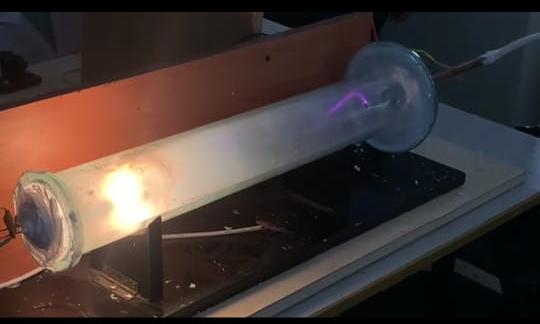- Hits: 1579
LINAC test 31.01.23
In previous tests, we achieved vacuum and then turned off the pump.
Here we will try to keep the pump running.
This test also differs from the previous one, that we moved the cathode back a little.
00002: power supply
| Step | Step description | Expected result | Result |
| Precondition | System is Off | ||
| Switch On the system | turn on the power supply (P1) | Get continuous power (6 V) | positive |
| Switch Off the system | turn Off the power supply (P1) | Continuous power stops | positive |
| Postcondition | System is Off |
00003: Get electrons
| Step | Step description | Expected Result | Result |
| Precondition | System is Off | ||
| Switch On the pump | turn On the pump | 95% vacuum | positive |
| Switch on the system | Turn on the power supply | Get continuous power (6 V) | positive |
| Burning the Tungsten (or use a electron gun) | Burn the Tungsten by supplying it with 6 V power |
Get electrons around the Tungsten (the lamp will light) |
positive (the lamp turned on) |
| Switch Off the power supply | turn Off the power supply |
the lamp will turn Off |
positive |
| Switch Off the pump | turn Off the pump |
the pump stops pulling out the air |
positive |
| Postcondition | System is Off |
00004:High voltage
| Step | Step description | Expected Result | Result |
| Precondition | System is Off | ||
| Switch On the system | Turn On the HV | Get continuous power ( between 5 Kv and 60 Kv ) | positive |
| Switch Off the system | Turn Off the HV | Continuous power stops | positive |
| Postcondition | System is Off |
00005: Acceleration of electrons
| Step | Step description | Expected Result | Result |
| Precondition | System is Off | ||
| Switch On the pump | |||
| Switch On the power supply | |||
| Switch on the High Voltage | Turn on the HV power supply | Get continuous power ( between 5 Kv and 60 Kv ) | positive |
| electrons acceleration | Connecting the high voltage to the anode and the cathode (while controlling the change of force until we see the passage of electrons and their acceleration) | Electrons leaving the anode accelerate towards the cathode and collide with it | positive ( light appears between the anode and the cathode) |
| Switch Off the HV | Turn off The HV power supply | Electrons acceleration Stop | positive |
| Switch Off the power supply | turn Off the power supply | the lamp will turn Off | positive |
| Switch Off the pump | Turn Off the pump | the pump stops pulling out the air | positive |
| Postcondition | System is Off |
Analysis of the test results:
In this test, we used a lamp with filaments of good thickness, and we attached tungsten to these filaments.
Then we supplied the lamp with a power of 6 V, and it lit up, which indicates that we have obtained electrons.
After this stage, we turned on the high voltage, and we saw a violet light path, which indicates that electrons are moving quickly between
the anode and the cathode.
But the problem was that the light path was tortuous and not straight + the tungsten was burned due to air entering it, This led to the appearance of a white powder inside the tube.
But despite the burning of the tungsten, we still have electrons (due to the presence of high voltage) and they continue to cross the path.
When we turned on the pump and kept it running, the path of the electrons began to adjust and became almost straight.
And after a while, with the pump still running, the violet color started to go, as electrons continued to cross its path.
Turning on the 6 v and high voltage:


After a while, the tungsten burned out , but electrons continued to pass through:


Here we started running the pump continuously:


with the pump on, the color gradually began to fade, as the path became straighter:


Here we turned off the pump, the color came on again and the track started meandering:

This white powder that appeared after the combustion of tungsten:


Combustion of tungsten:

What we have to do:
-we will run the pump from the beginning of the test until its end, to make sure that the burning of the lamp and the appearance of powder was due to the air that entered.
-HV experiment without providing the lamp with another power supply (6 V)
